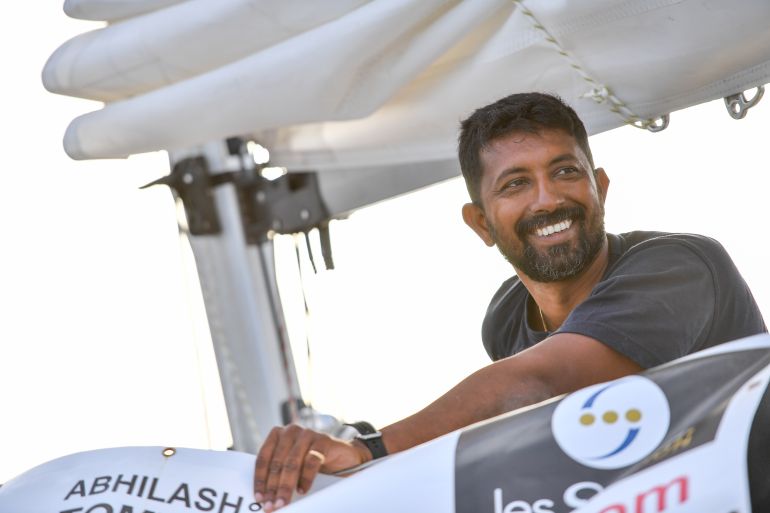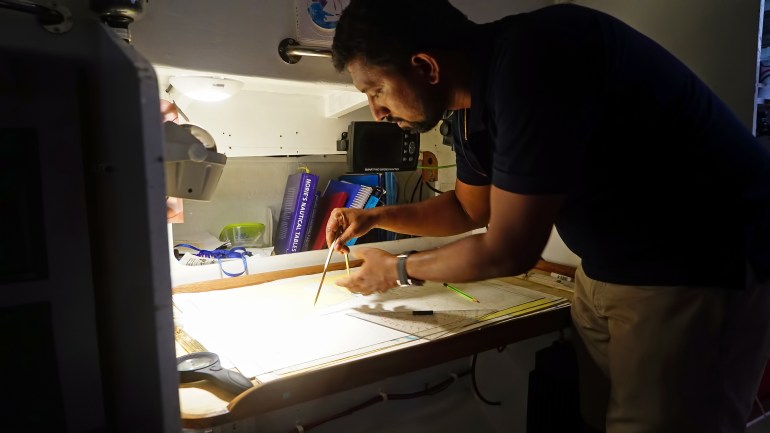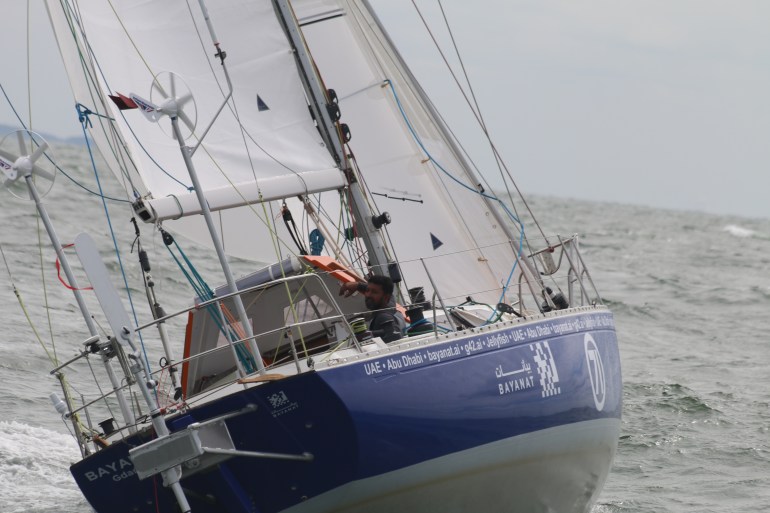Indian sailor Abhilash to return to race that almost killed him
In his first Golden Globe Race attempt four years ago, a storm hit Tomy’s vessel and he was left with severe injuries.

On the Twitter account of sailor Abhilash Tomy, a pinned tweet reads: “I will be taking part in the Golden Globe Race 2022 on the Bayanat. It is a big thing for me and here is why. On 18 Sept 2018, I was racing in the south Indian Ocean when we were caught in an unusual storm which claimed two of the three boats in its way. Mine was one of them.”
What follows is his account of how things unfolded. But what it fails to mention is the distress that Tomy experienced during those uncertain moments. And as he gears up for another attempt at the same race in September, it is not evident in his voice either.
Keep reading
list of 3 itemsA second chance for India’s Anwar Ali after a health-related ban
How chess prodigy Praggnanandhaa starred in cricket-crazy India
“Of course, I do think about the attempt, but there is no emotional quotient involved. It’s pretty prosaic, a very practical look at what happened,” Tomy told Al Jazeera.
The Golden Globe Race (GGR) is an invitational race which features some of the most experienced sailors from around the world.
It involves a circumnavigation of the globe, starting from Les Sables-d’Olonne in France.
There are no modern navigation tools to tackle 30,000 nautical miles (55,560km) or for communication with the world except on a few occasions when the rules permit.
A call for rescue or help means disqualification.
I will be taking part in the Golden Globe Race 2022 on the Bayanat. It is a big thing for me and here is why.
On 18 Sep 2018, I was racing in the south Indian Ocean when we were caught in an unusual storm which claimed two of the three boats in its way.
Mine was one of them.
— Abhilash Tomy – Racing Bayanat in GGR 🇦🇪 🇮🇳 (@abhilashtomy) March 22, 2022
As a former sailor and pilot in the Indian Navy, Tomy became the 200th person in the world to pull off a solo, non-stop circumnavigation in 2012-13.
Starting off at the Gateway of India in Mumbai, he travelled southeast towards New Zealand, rounded the Cape of Horn, before heading north towards the Cape of Good Hope, and back to the starting point in India.
“I believe you need to have certain qualities which will help you survive. I am very patient, I am very happy being alone, I don’t get bored with myself. And being a pilot, I’ve learned the importance of following procedures,” Tomy added.
And some of these traits were critical when it was down to survival during his first GGR attempt four years ago.
Somewhere in the south Indian Ocean, he was running third when the storm hit Tomy’s vessel, a 32 feet masted ketch christened Thuriya.
They were blasted by strong winds measuring 70-80 knots (130-150kmph), which rapidly changed direction, causing gigantic waves that flipped the sailboat over. It stood upright on its hull again, but toppled a second time.
When it straightened out, Tomy was caught on the mast. He fell what he remembers to be anywhere between 5 metres and 9 metres (16-30 feet).
“My back hit the boom. Once back inside the boat, the pain got severe so I tried sitting in vajrasana [thunderbolt or diamond pose]. That didn’t make things better, my knees kept buckling when I tried to stand.”
On realising that something was wrong, Tomy called for rescue. After spending 80 days out at sea, his race was run.
For more than three days, he lay in wait before help finally arrived.

Tomy said, “I was making a mental note of the things I needed to tell the doctor. And where the rescuers could find essentials like my passport, documents and phone. Then, I looked forward to meeting my pregnant wife. And, of course, I was planning my next attempt.
“This has been unfinished business ever since that day.
“But I didn’t really carry any post-traumatic stress disorder with me. There was no remorse or regret. I think it comes from spending a lot of time alone at sea.”
It was only when he returned to India that he was told the extent of the damage.
Surgery followed and five bones of his vertebrae were fused into a single unit. Two weeks later, he returned home to Goa to begin rehabilitation – he had to learn to walk all over again.
“Whenever we spoke, he would downplay everything,” Urmimala, Tomy’s wife, said.
“I just knew that he had injured his back, until I read a newspaper report that gave more details. He’s the kind of person who doesn’t want you to feel sorry for him. All I remember is that when I first saw him at the hospital, I knew I had to get this man on his feet as quickly as I could. Because the person that lay there wasn’t who Tomy was.”
The period of convalescence had other challenges besides physical recovery.
Urmimala recalled Tomy’s toughest moment was when he realised he could not help out his pregnant wife. Then, there was the heavy investment to think about that he had made to get to the start line.
“Most of it was my money, savings and all that. And now I had nothing to show for it. It was madness,” Tomy said.
What kept him going was the fact that he was already planning the race again, his wife remembered.
“It is what he loves doing. And the birth of our boy, Abhraneil, helped him recover sooner,” Urmimala said.

After hobbling around on crutches and several rounds of physiotherapy, Tomy took on a rigorous routine that involved a mix of gym workouts, pilates and kickboxing. A little more than a year after the accident, Tomy had to clear rigorous medicals with the navy to resume his pilot duties – a drill that climaxed with escaping from an underwater aircraft.
All along, the race was at the back of his head.
But his wait continued for two years due to the coronavirus pandemic. Right through this period, he read books on celestial navigation and plotted a plan for his next attempt.
He even opted for early retirement from the navy in January last year to focus on the race.
Things started falling in place by March 2021. Tomy found a backer in Bayanat, a company based out of the United Arab Emirates.
He sourced a Rustler 36 from a French sailor and moved to Europe to ready it alongside a Dutch boat maker.
On July 15, he tested waters by setting out on a 2,000-mile (3,218km) qualification passage. The heavy shipping traffic meant he had to stay alert and survive on three to four hours of sleep each day for a week.
Hallucinations
That led to hallucinations in the dead of the night.
“It was pretty bad. I heard myself speak in Malayalam. It was my mother asking me to get some rest. Then I heard my wife say that I could take a nap once I got to the airport. And then I found myself looking for a taxi to get there. The good thing is that I recognised these as hallucinations, even though it had never happened to me before,” he said.
Besides a few minor niggles that he has been working on, the Bayanat was solid on the 19-day journey. He was soon tending to the final preparations for the race, stocking up on spares and supplies, especially his lifeline during circumnavigations: popcorn.
On August 14, Tomy took on the SITraN Challenge. Later that night, the Bayanat collided with a Dutch ship, some 120 nautical miles (222km) off the coast of Gijon.
A few hours after the incident, Tomy put out a statement on Twitter: “Minor brush with a ship. All good, sailing ahead full swing!”
The GGR 2022 is rescheduled to start on September 4 instead of its usual time in July. Tomy believes it has a lot to do with the weather, similar to what had afflicted him in 2018.
Just getting to the start line can be a challenge. Of the 32 entries, only 16 are likely to be part of the race.
“Last time, the primary aim was to make it to the start because it was a big thing for India. This time around, my goal is to finish.”